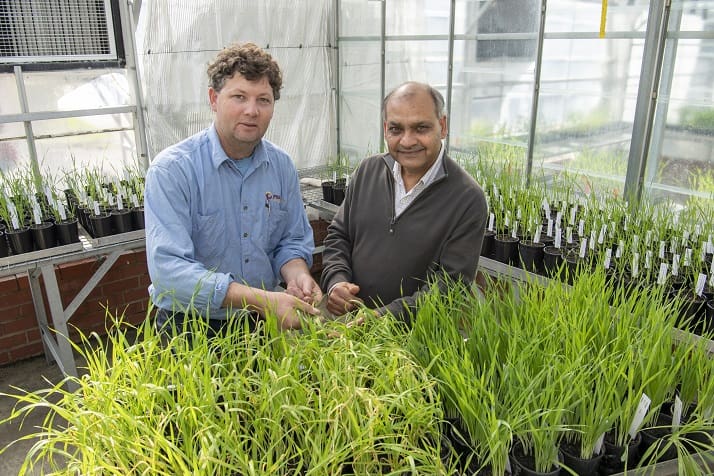
DPIRD technical officer Simon Rogers and Murdoch University researcher Dr Sanjiv Gupta compare the performance of two barley lines with different disease resistance gene combinations at DPIRD South Perth glasshouse.
BARLEY producers are set to benefit from new pre-breeding research to boost variety resistance to several major foliar diseases.
Western Australia’s Department of Primary Industries and Regional Development (DPIRD) and Murdoch University are about to commence a new phase of research that seeks to use a combination of genes to enhance disease resistance in barley.
The research is the culmination of decades of genetic and pathology research by the department to identify foliar disease resistance genes, with the support of the Grains Research and Development Corporation.
Murdoch University researcher Sanjiv Gupta leads the Western Australian component of the national collaborative research, based at the department and State Agriculture Biotechnology Centre.
Dr Gupta said the new project would evaluate the performance of a combination of nine genes that are resistant to four barley diseases.
“Past research by the department has identified two resistance genes each for powdery mildew, spot type net blotch and barley scald and three genes for net type net blotch,” he said.
“The department has been developing materials and evaluating the effectiveness of these genes in providing resistance to the individual diseases, which are now at an advanced stage of testing – giving confidence in the disease resistant germplasm.
“This next stage of research will evaluate the level of resistance provided by a combination of these disease resistance genes to the four diseases.”
Elite germplasm containing the combination of genes will be incorporated into a vast range of popular barley varieties and novel lines from Western Australia and the Eastern States.
Dr Gupta said the impact of the disease resistant elite germplasm on plant performance was a key consideration of the research, which includes yield, quality and agronomic traits.
“This information provides context for barley breeders to determine the relative benefit of improved disease resistance compared to any potential yield, quality or production compromise,” he said.
Foliar diseases typically reduce barley yields by 10 to 20 per cent, while highly susceptible crops can record yield losses of up to 40 per cent.
Dr Gupta said the research would ultimately result in new high performance barley varieties, with improved disease resistance, yield and quality.
“These new, more disease resistant varieties will underpin improved effective disease management strategies,” he said.
“Resistant varieties are easier to manage and require less protection and control measures, leading to reduced fungicide costs and improved profitability to the farming community.
“This will also result in additional benefits to the environment from a reduction in chemical use and a decreased risk of fungicide resistance.”
Breeding companies are likely to release varieties with the elite germplasm in the next five to seven years, while new lines with some of the disease resistant genes are currently being evaluated.
Source: DPIRD, agric.wa.gov.au
Grain Central: Get our free daily cropping news straight to your inbox – Click here

HAVE YOUR SAY